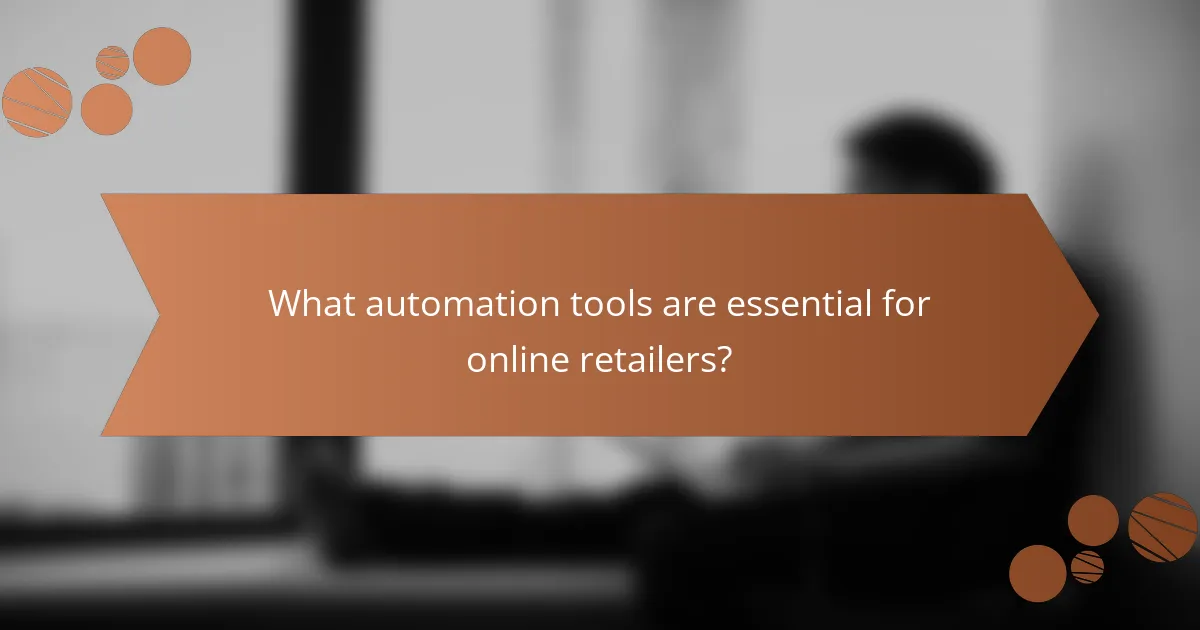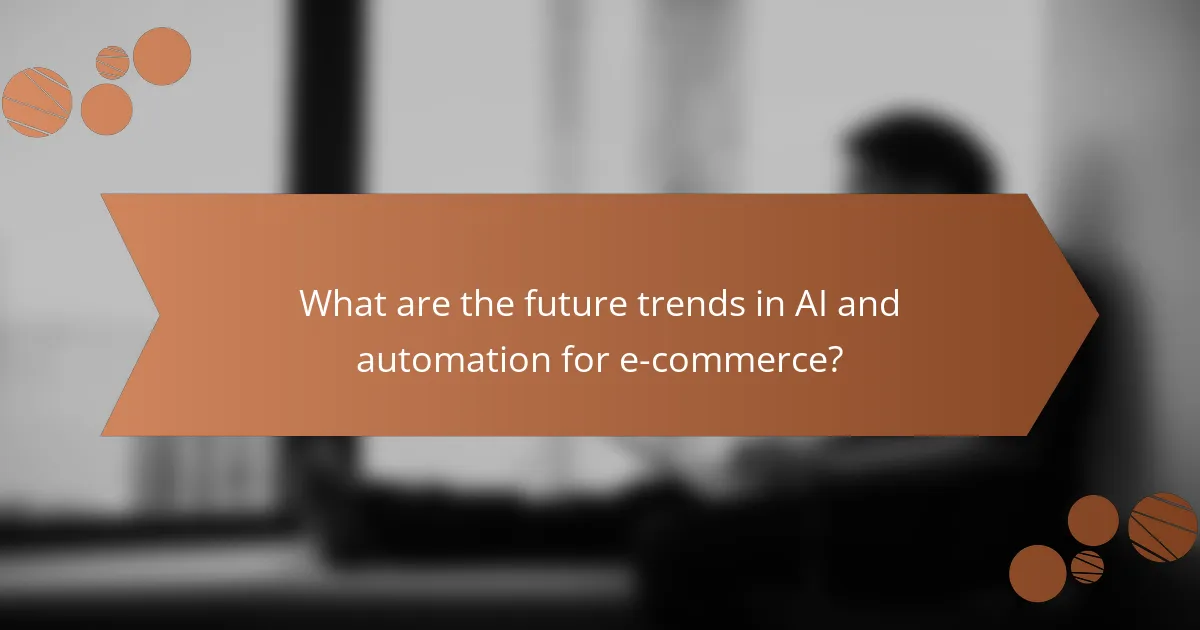Emerging technologies, particularly artificial intelligence and automation, are revolutionizing the way businesses operate and interact with consumers. By leveraging advanced algorithms and automation tools, companies can enhance customer engagement, streamline operations, and adapt swiftly to market changes. This technological shift not only drives sales and customer loyalty but also equips businesses with the agility needed to thrive in a rapidly evolving marketplace.

How is AI transforming e-commerce in the US?
AI is significantly reshaping e-commerce in the US by enhancing customer engagement, streamlining operations, and improving overall efficiency. Through advanced algorithms and machine learning, businesses can offer tailored experiences that drive sales and customer loyalty.
Personalized shopping experiences
AI enables e-commerce platforms to create personalized shopping experiences by analyzing customer data and behavior. By using algorithms that track browsing history, purchase patterns, and preferences, retailers can recommend products that are more likely to appeal to individual shoppers.
For example, platforms like Amazon utilize AI to suggest items based on previous purchases and searches, increasing the likelihood of additional sales. This level of personalization can lead to conversion rates that are significantly higher than generic marketing approaches.
Inventory management optimization
AI optimizes inventory management by predicting demand and automating stock replenishment processes. Machine learning models analyze sales data, seasonal trends, and market conditions to forecast inventory needs, helping businesses maintain optimal stock levels.
Retailers can reduce excess inventory and minimize stockouts, which is crucial for maintaining customer satisfaction. For instance, a clothing retailer might use AI to determine which items are likely to sell out quickly during a seasonal sale, allowing them to adjust their stock accordingly.
Customer service automation
AI-driven chatbots and virtual assistants are revolutionizing customer service in e-commerce by providing instant support and resolving queries without human intervention. These tools can handle a wide range of inquiries, from order tracking to product information, improving response times and customer satisfaction.
Many companies are implementing AI chatbots on their websites and social media platforms, allowing them to assist customers 24/7. This not only reduces operational costs but also ensures that customers receive timely assistance, which can enhance their overall shopping experience.

What automation tools are essential for online retailers?
Essential automation tools for online retailers streamline operations, enhance customer engagement, and improve efficiency. Key tools include e-commerce platforms with built-in automation features, workflow integration services, and email marketing solutions.
Shopify automation features
Shopify offers a variety of automation features that help online retailers manage their stores more efficiently. These include automated inventory management, order processing, and customer notifications, which reduce manual tasks and save time.
For instance, retailers can set up automatic alerts for low stock levels or create workflows that trigger emails to customers when their orders are shipped. This not only enhances customer experience but also ensures that retailers can focus on strategic tasks.
Zapier integration for workflows
Zapier allows online retailers to connect different applications and automate workflows without needing extensive coding knowledge. By creating “Zaps,” retailers can automate repetitive tasks such as transferring customer data between platforms or updating inventory records.
For example, a retailer can set up a Zap that automatically adds new customers from Shopify to a Mailchimp mailing list. This integration saves time and ensures that marketing efforts are consistently aligned with sales data.
Mailchimp for email marketing
Mailchimp is a powerful tool for email marketing automation, enabling retailers to create targeted campaigns based on customer behavior. It allows for segmentation, personalized messaging, and automated follow-ups, which can significantly increase engagement rates.
Retailers can utilize Mailchimp’s features to send welcome emails to new subscribers, abandoned cart reminders, or promotional offers based on purchase history. This targeted approach can lead to higher conversion rates and improved customer retention.

How can businesses adapt to market changes with technology?
Businesses can adapt to market changes by leveraging technology to enhance decision-making, streamline operations, and respond swiftly to consumer demands. Implementing tools like data analytics, agile supply chain management, and responsive pricing strategies enables companies to remain competitive and meet evolving market needs.
Data analytics for consumer insights
Data analytics allows businesses to gather and analyze consumer behavior, preferences, and trends. By utilizing tools such as customer relationship management (CRM) systems and social media analytics, companies can identify patterns that inform product development and marketing strategies.
For effective implementation, businesses should focus on key performance indicators (KPIs) relevant to their goals. Regularly reviewing these metrics can help in adjusting strategies to better align with consumer expectations. For example, a retail store might analyze purchasing trends to optimize inventory levels and improve customer satisfaction.
Agile supply chain management
Agile supply chain management involves creating a flexible supply chain that can quickly adapt to changes in demand or market conditions. This approach often includes real-time tracking of inventory and shipments, allowing businesses to respond promptly to disruptions or shifts in consumer preferences.
To achieve agility, companies should invest in technologies such as cloud computing and Internet of Things (IoT) devices. These tools facilitate better communication and coordination among suppliers, manufacturers, and retailers. For instance, a manufacturer might use IoT sensors to monitor equipment performance, enabling proactive maintenance and minimizing downtime.
Responsive pricing strategies
Responsive pricing strategies involve adjusting prices based on market conditions, competitor pricing, and consumer demand. Businesses can use dynamic pricing models that automatically change prices in real-time based on predefined criteria, maximizing revenue while remaining competitive.
When implementing responsive pricing, companies should consider factors such as customer segments and price elasticity. For example, an airline might lower prices during off-peak seasons to stimulate demand, while raising prices during high-demand periods. Regularly reviewing pricing strategies can help businesses stay aligned with market trends and consumer expectations.

What are the key challenges in adopting emerging technologies?
Adopting emerging technologies presents several challenges, including integration with existing systems, data privacy concerns, and employee training requirements. Organizations must navigate these obstacles to fully leverage the benefits of innovations like AI and automation.
Integration with existing systems
Integrating new technologies with current systems can be complex and resource-intensive. Companies often face compatibility issues, which may require significant adjustments to existing infrastructure or processes. A phased approach, where new solutions are tested in smaller environments before full-scale implementation, can help mitigate risks.
It’s crucial to assess the current technology landscape and identify potential integration points. For example, if a business uses a legacy system, it may need middleware solutions to bridge the gap between old and new technologies. Investing in flexible platforms that support interoperability can ease this transition.
Data privacy concerns
Data privacy is a significant concern when adopting emerging technologies, especially with AI systems that require large datasets. Organizations must comply with regulations like GDPR in Europe or CCPA in California, which impose strict guidelines on data collection and usage. Failure to adhere to these regulations can lead to hefty fines and damage to reputation.
To address privacy concerns, companies should implement robust data governance frameworks. This includes conducting regular audits, ensuring data anonymization, and obtaining explicit consent from users. Transparency in data handling practices can also build trust with customers and stakeholders.
Employee training requirements
Emerging technologies often necessitate new skills and knowledge among employees. Training programs should be developed to equip staff with the necessary competencies to operate and maintain these technologies effectively. Without adequate training, organizations risk underutilizing their investments in new tools.
Consider offering a mix of formal training sessions, online courses, and hands-on workshops to accommodate different learning styles. Additionally, fostering a culture of continuous learning can help employees adapt to ongoing technological changes. Regular feedback and support can further enhance the training process, ensuring that staff remain confident and capable in their roles.

How do consumer behaviors influence technology adoption?
Consumer behaviors significantly shape technology adoption by determining which innovations gain traction in the market. As preferences shift, businesses must adapt their offerings to meet evolving demands, leading to the integration of new technologies that enhance customer experiences.
Shift towards mobile shopping
The shift towards mobile shopping has accelerated as consumers increasingly prefer the convenience of purchasing via smartphones. This trend has prompted retailers to optimize their websites and applications for mobile use, ensuring seamless navigation and secure payment options.
To capitalize on this shift, businesses should focus on responsive design, fast loading times, and user-friendly interfaces. Offering mobile-exclusive discounts can also encourage more consumers to shop through their devices.
Demand for faster delivery options
Consumers are increasingly demanding faster delivery options, often expecting same-day or next-day service. This expectation has led companies to invest in logistics and technology to streamline their supply chains and improve delivery efficiency.
Businesses should consider implementing real-time tracking systems and partnering with local couriers to meet these demands. Offering various delivery options, including express shipping for an additional fee, can cater to different customer preferences.
Preference for sustainable practices
There is a growing preference among consumers for sustainable practices, influencing companies to adopt eco-friendly technologies and processes. This includes using recyclable packaging, reducing carbon footprints, and sourcing materials responsibly.
To align with this trend, businesses should transparently communicate their sustainability efforts and consider certifications that validate their practices. Engaging customers through initiatives like recycling programs can also enhance brand loyalty and attract environmentally conscious consumers.

What are the future trends in AI and automation for e-commerce?
The future of AI and automation in e-commerce is set to transform shopping experiences significantly, focusing on personalization, efficiency, and customer engagement. Key trends include the rise of voice commerce and the increased use of augmented reality, both of which enhance how consumers interact with online retailers.
Rise of voice commerce
Voice commerce is becoming a prominent trend as consumers increasingly use smart speakers and voice assistants to make purchases. This technology allows for hands-free shopping, enabling customers to place orders simply by speaking, which can streamline the buying process.
Retailers should optimize their platforms for voice search by using natural language processing and ensuring that product information is easily accessible. This includes focusing on conversational keywords and phrases that customers are likely to use when speaking.
To successfully implement voice commerce, businesses should consider integrating with popular voice platforms like Amazon Alexa or Google Assistant. Offering promotions or discounts for voice orders can also encourage adoption and increase sales.
Increased use of augmented reality
Augmented reality (AR) is revolutionizing the e-commerce landscape by allowing customers to visualize products in their own environment before making a purchase. This technology can significantly reduce return rates by helping consumers make more informed decisions.
Retailers can leverage AR by developing apps or features that enable customers to see how furniture fits in their living space or how clothing looks on them virtually. This interactive experience can enhance customer engagement and satisfaction.
To effectively use augmented reality, businesses should ensure that their AR applications are user-friendly and compatible with a wide range of devices. Investing in high-quality visuals and seamless integration into the shopping experience is essential for maximizing the impact of AR.


